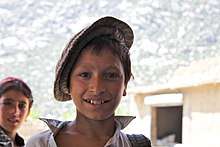Pashayi people
 Pashai boy wearing a pakul | |
| Total population | |
|---|---|
| Approx. 500,000[1] | |
| Regions with significant populations | |
| Laghman, Kapisa and Nangarhar | |
| Languages | |
|
Pashai language Pashto also spoken as second language[1] | |
| Religion | |
| Islam | |
| Related ethnic groups | |
| Kalash, Nuristani and Kashmiris |
Pashayi or Pashai (Persian: مردم پشهای) are a Dardic ethno-linguistic group living primarily in eastern Afghanistan. Their total population is estimated to be 500,000.[1]
Geography
They are mainly concentrated in the northern parts of Laghman, Nangarhar, Kunar, Kapisa, Kabul, Baghlan, Nuristan, and also in Ghazni. Some believe the Pashai are descendants of ancient Gāndhārī.[2][3] Many Pashai consider themselves Pashtuns speaking a special language,[4] and many are bilingual in Pashto.[1] Pashai communities can also be found in the Chitral district of northwestern Pakistan.
| “ | Pashae, or Pashie or ("Padshahi") are attributive plural forms, meaning of the ("Kingdom" Padshahi"'). The Pashai are still found by that name in the Bamian and Lughman districts in the southern valleys.[5] | ” |
History
The Pashayi people originally practiced Buddhism, with small minorities practicing Hinduism and other religions.[6][7]
Today, the majority of Pashai are Sunni Muslims and are often referred to as Kohistani,[4] while a minority are Nizari Ismaili Muslims.
Per Tabakat-i-Akbari of Nizamuddin Ahmad, Mughal Emperor Akbar had dispatched his younger brother Mirza Muhammad Hakim, who was a staunch adherent of the missionary-minded Naqshbandi Sufi order, against the infidels of Katwar in 1582.[8] Hakim was a semi-independent governor of Kabul.[9] The Sifat-nama-yi Darviš Muhammad Hān-i Ğāzī of Kadi Muhammad Salim who accompanied the expedition mentions its details.[8] The Sifat-nama gives Muhammad Hakim the epithet of Darviš Khan Gazi.[9]
Muhammad Darvish's religious crusade fought its way from Lamghan to Alishang, and is stated to have conquered and converted 66 valleys to Islam. After conquering Tajau and Nijrau valleys in Panjshir area, the crusaders established a fort at Islamabad at confluence of Alishang and Alingar rivers. They continued the raid up to Alishang and made their last effort against the non-Muslims of Alingar, fighting up to Mangu, the modern border between Pashai and Ashkun-speaking areas.[10]
Notable individuals
- Northern Alliance commander Hazrat Ali
See also
References
- 1 2 3 4 http://www.sil.org/asia/ldc/parallel_papers/ju-hong_yun.pdf
- ↑ Pashai. Everyculture.com. Retrieved on 2013-07-12.
- ↑ M. Longworth Dames; G. Morgenstierne & R. Ghirshman (1999). "AFGHĀNISTĀN". Encyclopaedia of Islam (CD-ROM Edition v. 1.0 ed.). Leiden, The Netherlands: Koninklijke Brill NV.
- 1 2 Pashai, Ethnic identity in Afghanistan, on nps.edu
- ↑ Henry Walter Bellew An Inquiry into the Ethnography of Afghanistan; p. 143
- ↑ Weekes, Richard V. (1984). Muslim peoples: a world ethnographic survey. Greenwood Publishing Group. p. 601. ISBN 9780313233920.
- ↑ Khanam, R. (2005). Encyclopaedic ethnography of Middle-East and Central Asia. Global Vision Publishing House. p. 631. ISBN 9788182200654.
- 1 2 C. E. Bosworth; E. Van Donzel; Bernard Lewis; Charles Pellat (eds.). The Encyclopaedia of Islam, Volume IV. Brill. p. 409.
- 1 2 C. E. Bosworth. "Ğihād in Afghanistan and Muslim India". Israel Oriental Studies. Tel Aviv University. 10: 153.
- ↑ Alberto M. Cacopardo, Augusto S. Cacopardo. Gates of Peristan: history, religion and society in the Hindu Kush. Istituto Italiano per l'Africa e l'Oriente. p. 32.
External links
![]()